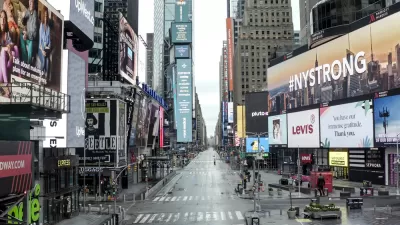Despite some transformative changes and brief spikes in domestic migration, the Covid-19 pandemic seems to be exacerbating existing declines in internal mobility.

A new brief from Riordan Frost of the Joint Center for Housing Studies of Harvard University updates Frost’s prior research on residential migration in the United States, revealing new insights about migration since the start of the pandemic and how it compares to previous trends.
Frost explains that “residential mobility rates have been declining for the past four decades,” and, aside from two spikes in the first year of the pandemic, trends stayed largely the same.
“One finding was that the types of moves and movers that had the steepest mobility rate declines before the pandemic remained the same during the pandemic.” Mobility rates declined across age, race, and ethnicity groups, but households with higher incomes were more likely to move. “Perhaps most notably, rural counties attracted more migrants than usual” as remote work untethered people from cities and high housing costs drove them farther out.
Monthly data allows for more nuanced analysis. “These data reveal that moves spiked twice early in the pandemic before reverting to pre-pandemic levels by the end of 2021 and falling further throughout 2022. As a result, USPS data show all types of moves—individual, family, permanent, and temporary—were lower in 2022 than before the pandemic.” Interestingly, “there were no mobility spikes during later surges like those associated with the Delta and Omicron variants.”
Frost concludes that “The paradigm-shifting nature of the pandemic makes it difficult to assess whether and how mobility patterns will change in coming years, but there are many factors pointing to a continued decline in mobility rates.”
FULL STORY: MOVING DURING THE PANDEMIC: MASS EXODUS OR MASS INERTIA?

Alabama: Trump Terminates Settlements for Black Communities Harmed By Raw Sewage
Trump deemed the landmark civil rights agreement “illegal DEI and environmental justice policy.”

Planetizen Federal Action Tracker
A weekly monitor of how Trump’s orders and actions are impacting planners and planning in America.

The 120 Year Old Tiny Home Villages That Sheltered San Francisco’s Earthquake Refugees
More than a century ago, San Francisco mobilized to house thousands of residents displaced by the 1906 earthquake. Could their strategy offer a model for the present?

Ken Jennings Launches Transit Web Series
The Jeopardy champ wants you to ride public transit.

BLM To Rescind Public Lands Rule
The change will downgrade conservation, once again putting federal land at risk for mining and other extractive uses.

Indy Neighborhood Group Builds Temporary Multi-Use Path
Community members, aided in part by funding from the city, repurposed a vehicle lane to create a protected bike and pedestrian path for the summer season.
Urban Design for Planners 1: Software Tools
This six-course series explores essential urban design concepts using open source software and equips planners with the tools they need to participate fully in the urban design process.
Planning for Universal Design
Learn the tools for implementing Universal Design in planning regulations.
Clanton & Associates, Inc.
Jessamine County Fiscal Court
Institute for Housing and Urban Development Studies (IHS)
City of Grandview
Harvard GSD Executive Education
Toledo-Lucas County Plan Commissions
Salt Lake City
NYU Wagner Graduate School of Public Service





























